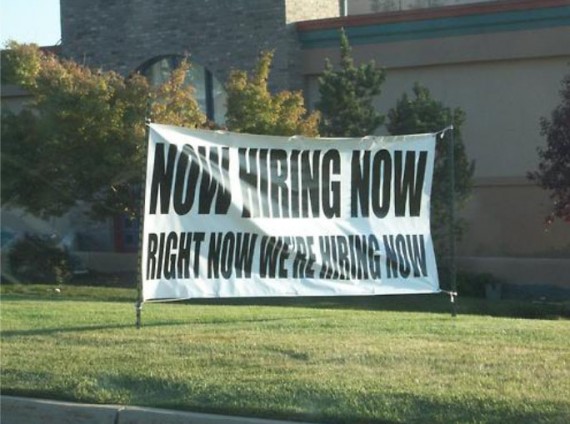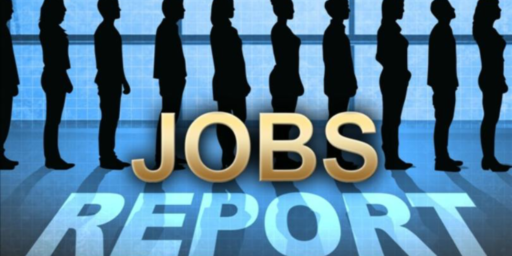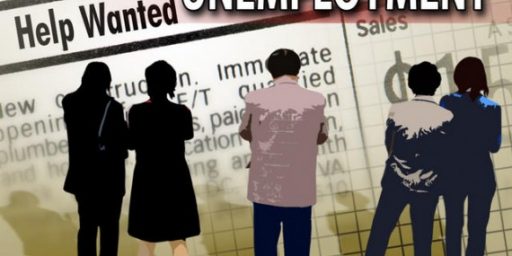February Jobs Report Better Than Expected, Still Nothing To Write Home About
After two months in which the monthly jobs report fell far below expectations, analysts weren’t expecting very much out of February’s numbers before they came out this morning. In addition to the fact that it’s the shortest month of the year, it also happened to be a month in which large segments of the country were hit with sub-zero temperatures and snow and ice storms that paralyzed metropolitan areas from Boston to Chicago to Atlanta. Earlier this week, those presumptions seemed to be confirmed when the ADP jobs report, which sometimes correlates to what we say from the Bureau Of Labor Statistics and often doesn’t came in with one of its more dismal reports in some time. As it turned out, though, we ended February in better shape that anticipated:
The American economy stirred to life last month, creating more jobs than in the previous two winter months and raising hopes that momentum in the labor market would gradually pick up as the cold weather in many parts of the country eases with the arrival of spring.
The report from the Labor Department for February, which came on Friday after job figures for December and January that were much weaker than the underlying trend, eased fear that the economy was downshifting to a slower pace. The data led some experts to conclude that weather, not a fundamental slowdown, was a major factor behind the recent shortfalls.
With employers hiring 175,000 workers, the payroll gain in February was hardly cause for celebration — it was still well short of the pace needed to return the economy to full employment in the next few years. But it was twice the number added in December, when the cold and snow arrived.
“It’s a normalization,” said Julia Coronado, chief economist for North America at BNP Paribas. “It’s not clear just how much effect the weather had, but it seems like we’re on a moderate but steady hiring trend.”
The unemployment rate rose 0.1 percentage point to 6.7 percent, a reversal of the sharp downward trend recorded since last summer. Some experts argued that was not cause for alarm, but rather a sign that more people were moving back into the labor force and searching for jobs as openings increased.
The Labor Department announcement had been awaited eagerly and was viewed as a wild card, with economists struggling to estimate the impact of wintry weather in many parts of the country as well as seasonal adjustments by government statisticians.
Before Friday’s report, the consensus among economists on Wall Street called for employers to have added 149,000 positions in February, with the jobless rate remaining flat at 6.6 percent.
In December, the economy added 84,000 jobs, and in January, it created 129,000 positions. Both numbers fell well short of expectations among experts on Wall Street.
The December and January numbers were revised upward by a net total of 25,000 jobs, which makes the disappointing numbers from those months slightly more respectable, although not by much. As for February, it’s hard to tell what these numbers mean without seeing what happens as we head into the spring, and hopefully better weather than we’ve had the past three months or so. As it stands, we’re still averaging monthly net job creation around 182,000 per month, which is okay but far from ideal given the depths of the jobs recession that we experienced in the wake of the 2008 economic crisis. Indeed, at this point a major concern is that the jobs market may not fully recover before the economy gets pushed back into another recession which, given the law of averages, ought to happen at some point before President Obama leaves office. If it does, then we could be looking at a Presidential election in the midst of another economic downturn and a large number of unemployed people looking to someone for an answer. At the very least, that would make things interesting.





A report also blows a hole in the idea that Obamacare would force employers to choose part time over full time. Nope.
It seems the biggest drag in employment is not Obamacare but austerity. Thanks again, Republicans.
we’ll be back to pre-recession employment numbers this summer and will have accomplished it entirely with private sector jobs…a radical policy implementation that has never been done before…and held back by public sector cuts.
http://sullydish.files.wordpress.com/2014/03/job-losses.jpg
also…the recession actually began in December of ’07.
@michael reynolds:
I’m sure Jenos and JKB will be around anytime now to acknowledge they were dead wrong…again.
@michael reynolds:
In addition it’s mostly State and Local governments cutting workers hours…with private sector work hours largely unchanged.
Nothing to write home about?
We all miss those days in early 2009 when the economy was shedding jobs at a rate of over 700,000 per month.
More ignorant excuse making for 5+ years of failure. The lowest labor force participation in 35 years with 0 wage growth.
There is a book out now, The Second Machine Age, by Erik Brynjolfsson, Andrew McAfee.
It is blowing up big. It is possibly the “jobs” book of 2014.
It is all about the accelerating rate of replacement of jobs by automation.
The book fairly well aligns with the sort of robo-socialism that michael and I have been talking about.
A little longer term than one jobs report, but you might want to touch bases with reviews and the buzz on that book.
@Bandit:
To use labor force participation, by itself, you want a stable demographic. We don’t have that. We have retiring boomers.
Now, I happen to think that not all retiring boomers have done so with full intent. Many have been retired, by the market.
How to know? U6 unemployment is probably the best available number, even if it does not include people who “decided” to retire after the market “decided” not to hire them.
Anyway, U6 unemployment is improving, but has a distance to make up.
@john personna:
Just bought the executive summary. I’m in the middle of researching a very different topic, but I should be able to absorb this.
i see most of you have your rose colored glasses on, last i checked the “food stamp” nation is not really doing so well. but go ahead and cherry pick a few positive signs that all is well, if it’s working for you.
@michael reynolds:
One of their central ideas caught me off guard. It is that AI is (finally) accelerating, perhaps not toward thinking machines, but in peeling off “difficult” tasks more rapidly. As someone used to slow but steady progress this was a surprise.
And then I saw this:
Robot rides a fixie.
The amazing thing is that the robot has regular walking feet, and starts and stops by putting his feet on and off the pedals.
@bill:
As you may have noticed bill, conservatives are reduced to sniping from the edges, carefully without discussing plans or strategies.
They now know, if they are following the economic studies rolling it, that the Great Recession was quite real, that emergency measures were needed to save the economy, and that stimulus worked.
@john personna:
The executive summary wasn’t great unfortunately. So I will lazily rely on you to actually read the thing. I am neck-deep in WW2 for a books series I’m writing, force-feeding myself books, audio books, podcasts, DVDs, old movies, old magazines, even the old radio plays from the 40’s that are on Sirius.
@Bandit:
Excuse making? I’m not sure that you got the word, but the catastrophic 2008 crash of the financial and housing markets caused the loss of over 20% ($17 Trillion) of the total wealth of America businesses and households.
So, yes, economic and job growth has been low since that crash, for reasons that are obvious to everyone (except those who reflexively blame Obama for everything.)
@al-Ameda:
Well, what are you going to do? Blame a white man? Blame always falls on the Jew or the black man.
So Doug is still pretending that the 2008 financial crisis and the Republican response of imposing austerity has nothing to do with the current high unemployment and John Persona is still insisting that the high unemployment is all structural, despite the consensus among economists that its primarily cyclical. Oh well, Doug can trot out the same stuff same time next month.
Let me just state the truth again for the record:
1. The current high unemployment stems directly from the collapse in aggregate demand caused by 2008 financial crisis-a crisis caused largely by the Bush Administration’s failure to properly regulate the financial markets.
2. That failure to regulate was caused in part by the Bush Administration’s devotion to the conservative/libertarian concept of the Efficient Market Hypothesis, , which said in effect that unregulated financial markets could never crash because laissez faire pixie dust.
3. Conservatives not only have since pretended that the 2008 crisis never happened, but have insisted that the cure for the economic collapse was austerity, belt tightening and more lately blaming workers for being “unemployable”.
4. The Obama Administration, in an attempt to achieve “reasonable bipartisan compromise”, implemented a stimulus that was too small and poorly designed to return the economy to full unemployment, despite the warnings of Krugman and other liberals.
5.The Republicans took advantage of the resulting high unemployment to discredit the very idea of further stimulus spending and to play on the economic fears of older whites and engineered a political resurgence in 2010. The resurgent Republicans not only blocked further stimulus but instituted an austerity program that kept the economy depressed and unemployment rates higher than they should be.
6. Conservatives and a few misguided liberals have steadfastly blamed the continuing high unemployment on deficits, worker training, robots, “structural factors”, Obamacare, regulations, uncertainty -everything but a lack of aggregate demand. They have never bothered to explain why unemployment was much lower before the 2008 financial crisis, despite all those factors being present. The result is that a second round of stimulus has been absolutely ruled out by politicians, although the consensus among economists is that it would be helpful in lowering unemployment .
Now that’s the truth, folks, which I’ll be repeating every time another of these benighted posts go up. Any questions?
@michael reynolds:
If you twitter you can add @erikbryn and @amcafee to your feeds and you’ll get their stuff a little at a time.
Having read part of the book, for now, I’d say that they do a really good job of putting things we know (if we have been tracking technology and jobs) in historical perspective.
I mean, I knew that computers were ridiculously cheap and powerful, but I didn’t know that the iPad had roughly the power of a Cray II supercomputer, of cold war fame(*)
* – slightly suspicious of the metric used (vector graphics v vector math), but still, the ballpark is impressive enough
I think that one thing that dawned on me was that while literally “self driving cars” might still be 20 years away, the early experiments mean more to other fields and jobs. The tech in a self driving car is still hard, but suddenly a Kiva warehouse robot is easy.
@stonetools:
I know he has already responded, but to be fair I don’t think he has ever said unemployment is all structural. The two of you disagree on how much is structural vs how much is cyclical not on whether those two components exist. There is obviously some structural unemployment and it is equally obvious that there is a cyclical component, what is less easy to ferret out is how much each is contributing at any given time. I lean more to the Krugman explanation, but we are talking about differences in degree not differences in kind.
@john personna: can’t argue there- but 5 yrs later and the fed is still propping up the economy with no interest? people have to put their money in stocks as they can’t earn anything with the banks (which in turn makes wall st look better than it really is). it’s a gamble but it beats paying the bank to keep your money. i won’t delve into the food stamp nation crap as it’s quite embarrassing for us all.
@Grewgills:
I missed that slur completely, guess I wasn’t reading stonetools at all.
I never named an amount that was structural. Part of that is because it’s hard to really know, and part of it is that the trend is easier to see, without knowing the levels.
‘The Second Machine Age,’ by Erik Brynjolfsson and Andrew McAfee